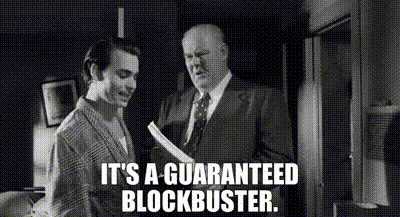Blockbusters, a term that has become synonymous with Hollywood‘s most successful and memorable films, have evolved dramatically over the decades.
From the early days of cinema to the high-tech spectacles of the 21st century, blockbusters have mirrored the technological advancements, cultural shifts, and economic realities of their times.
Let’s trace the evolution of blockbusters, examining the changing trends, themes, and special effects that have shaped the genre, and comparing classic blockbusters with modern-day spectacles.
The Birth of the Blockbuster
The term “blockbuster” originally referred to bombs capable of destroying entire city blocks during World War II.
However, by the 1940s, the term was co-opted by the entertainment industry to describe films that were highly successful at the box office.
Early blockbusters were distinguished by their large-scale production, star-studded casts, and wide audience appeal.
One of the earliest examples of a blockbuster is “Gone with the Wind” (1939). Directed by Victor Fleming, this epic historical romance was a monumental production for its time, featuring a sweeping narrative set against the backdrop of the American Civil War.
Its grand scale, coupled with a strong box office performance, set the stage for what would become the blockbuster model: a high-budget film designed to attract a mass audience.
Another key moment in the history of blockbusters was the release of “Ben-Hur” (1959). Directed by William Wyler, this biblical epic was a staggering production, featuring one of the most famous chariot race scenes in cinema history.
“Ben-Hur” was not only a critical success but also a commercial juggernaut, winning 11 Academy Awards and becoming the highest-grossing film of the year.
The film’s success demonstrated the appeal of large-scale, spectacle-driven cinema, a hallmark of the blockbuster genre.
The Rise of the Modern Blockbuster: The 1970s and 1980s
The modern blockbuster era is often traced back to the release of “Jaws” (1975), directed by Steven Spielberg.
“Jaws” was a game-changer in many ways. It was one of the first films to be released nationwide simultaneously, accompanied by a massive marketing campaign.
The film’s success demonstrated the power of a wide release strategy combined with heavy advertising, a model that would become the norm for blockbuster films.
“Jaws” also introduced the concept of the summer blockbuster. Released in June 1975, the film’s success during the summer months led studios to realize the potential of this season for releasing their biggest films.
This trend has continued to the present day, with summer being the prime season for blockbuster releases.
Just two years later, in 1977, “Star Wars” (later retitled “Star Wars: Episode IV – A New Hope”) would further solidify the blockbuster model.
Directed by George Lucas, “Star Wars” was a groundbreaking film in many ways. Its blend of science fiction, fantasy, and adventure, combined with cutting-edge special effects, captured the imagination of audiences worldwide.
“Star Wars” also spawned an entire franchise, including sequels, prequels, spin-offs, and merchandise, making it one of the most successful and influential blockbusters of all time.
The success of “Jaws” and “Star Wars” ushered in an era where blockbusters became the driving force of Hollywood.
The 1980s saw the release of numerous iconic blockbusters, including “E.T. the Extra-Terrestrial” (1982), “Raiders of the Lost Ark” (1981), and “Back to the Future” (1985).
These films were characterized by their broad appeal, high production values, and reliance on special effects.
The 1980s also saw the rise of the sequel and the franchise, with films like “The Empire Strikes Back” (1980) and “Indiana Jones and the Temple of Doom” (1984) becoming huge hits.
The Evolution of Special Effects
One of the defining features of blockbusters is their use of special effects to create visually stunning and immersive experiences.
The evolution of special effects has been closely tied to the evolution of the blockbuster genre.
In the early days of cinema, special effects were achieved through practical means, such as miniatures, matte paintings, and in-camera effects.
Films like “King Kong” (1933) and “The Wizard of Oz” (1939) were groundbreaking in their use of these techniques to create fantastical worlds.
The 1970s and 1980s saw significant advancements in special effects technology. “Star Wars” and “Close Encounters of the Third Kind” (1977) were among the first films to use computer-controlled cameras and motion control technology, allowing for more dynamic and realistic special effects shots.
“Tron” (1982) was one of the first films to use extensive computer-generated imagery (CGI), although the technology was still in its infancy.
The 1990s marked a turning point in the use of CGI with the release of “Jurassic Park” (1993). Directed by Steven Spielberg, “Jurassic Park” used CGI to bring dinosaurs to life in a way that had never been seen before.
The film’s success demonstrated the potential of CGI to create realistic and believable special effects, paving the way for its widespread use in blockbusters.
Another milestone in the evolution of special effects was “The Matrix” (1999).
Directed by the Wachowskis, “The Matrix” popularized the use of “bullet time” effects, where the action appears to slow down while the camera moves at normal speed.
This technique, combined with innovative use of CGI, created a visually stunning and highly stylized film that influenced many subsequent blockbusters.
The 2000s and 2010s saw the rise of CGI-heavy blockbusters, with films like “The Lord of the Rings” trilogy (2001-2003), “Avatar” (2009), and “The Avengers” (2012) pushing the boundaries of what was possible with digital effects.
“Avatar,” in particular, was a game-changer, using groundbreaking motion capture technology and 3D effects to create an immersive and visually stunning world.
The Franchise Era
The success of films like “Star Wars” and “Indiana Jones” in the 1970s and 1980s laid the groundwork for the franchise era of blockbusters.
Studios realized the potential of creating sequels, prequels, and spin-offs to capitalize on the success of popular films.
The 2000s and 2010s saw the rise of the franchise model, where blockbusters were not just standalone films but parts of larger, interconnected universes.
The “Harry Potter” series, which began with “Harry Potter and the Sorcerer’s Stone” (2001), was one of the first major film franchises of the 21st century.
Based on the popular book series by J.K. Rowling, the films were released over a decade and became some of the highest-grossing films of all time. The success of the “Harry Potter” franchise demonstrated the potential of adapting popular books into blockbuster films.
The Marvel Cinematic Universe (MCU), which began with “Iron Man” (2008), took the franchise model to a new level. The MCU is a shared universe of interconnected films featuring characters from Marvel Comics.
The success of the MCU has been unprecedented, with films like “The Avengers” (2012) and “Avengers: Endgame” (2019) becoming some of the highest-grossing films of all time. The MCU’s success has led other studios to attempt to create their own shared universes, with varying degrees of success.
The rise of the franchise model has had a significant impact on the blockbuster genre.
Studios are increasingly focused on creating films that can serve as the foundation for a larger franchise, leading to a trend of interconnected films and spin-offs.
This has led to some criticism that the focus on franchises has stifled creativity and led to a lack of originality in blockbuster films.
Changing Themes and Trends
Over the decades, the themes and trends of blockbusters have evolved to reflect the cultural and social issues of the times.
Early blockbusters like “Gone with the Wind” and “Ben-Hur” were often historical epics that focused on grand, sweeping narratives.
The 1970s and 1980s saw the rise of the sci-fi and fantasy blockbuster, with films like “Star Wars” and “E.T.” exploring themes of adventure, heroism, and the battle between good and evil.
The 1990s saw a shift towards more diverse themes and genres in blockbuster films. “Titanic” (1997), directed by James Cameron, was a romantic disaster film that became one of the highest-grossing films of all time.
“The Matrix” explored themes of technology, reality, and identity in a dystopian future, reflecting the growing anxiety about the impact of technology on society.
The 2000s and 2010s saw the rise of superhero films as a dominant force in the blockbuster genre.
The success of the MCU has led to a proliferation of superhero films, with characters like Iron Man, Captain America, and Spider-Man becoming cultural icons.
These films often explore themes of power, responsibility, and the battle between good and evil, resonating with audiences in a time of political and social uncertainty.
Another trend in modern blockbusters is the focus on nostalgia and reboots.
Films like “Jurassic World” (2015), “Star Wars: The Force Awakens” (2015), and “Ghostbusters” (2016) have capitalized on the nostalgia of audiences who grew up with the original films.
This trend reflects a desire for familiar stories and characters in an era of rapid change and uncertainty, where audiences find comfort in the known and cherished.
The Role of Technology and Special Effects in Modern Blockbusters
The continuous advancements in technology have played a crucial role in shaping modern blockbusters.
As special effects have become more sophisticated, filmmakers have been able to create increasingly spectacular and immersive experiences for audiences.
This technological evolution has not only expanded the scope of what can be depicted on screen but has also influenced the storytelling methods employed by directors.
Computer-Generated Imagery (CGI) has become a cornerstone of modern blockbuster filmmaking. The early use of CGI in films like “Tron” and “Jurassic Park” laid the groundwork for its widespread adoption in the 21st century.
Today, CGI is used not only to create fantastical creatures and expansive landscapes but also to enhance more grounded, real-world settings. The “Transformers” series, for example, relies heavily on CGI to bring its giant robots to life, while films like “Inception” (2010) use CGI to manipulate reality in mind-bending ways.
Motion capture technology has also revolutionized the way characters are brought to life on screen. Films like “The Lord of the Rings” trilogy used motion capture to create the character of Gollum, played by actor Andy Serkis.
This technology has since been used in films like “Avatar” and “Planet of the Apes” (2011) to create highly realistic and emotionally resonant characters that are entirely digital but driven by human performances.
Another significant technological advancement in recent years is the resurgence of 3D and IMAX formats. James Cameron’s “Avatar” was a major catalyst for the modern 3D revolution, offering audiences an immersive experience that was previously unparalleled.
IMAX has also become increasingly popular for blockbuster releases, offering a larger-than-life viewing experience that draws audiences into the spectacle on screen.
The role of technology in modern blockbusters extends beyond the screen as well. The rise of digital distribution and streaming platforms has transformed how audiences access and consume blockbuster films.
While the traditional cinema experience remains central to the blockbuster model, films are now available on streaming services much sooner, and in some cases, simultaneously with their theatrical release.
This shift has opened up new avenues for audience engagement and revenue generation but has also raised questions about the future of the traditional moviegoing experience.
Comparing Classic Blockbusters with Modern-Day Spectacles
While the fundamental elements of blockbusters—big budgets, star power, and mass appeal—have remained consistent over the decades, the ways in which these elements are executed have evolved significantly.
Comparing classic blockbusters with modern-day spectacles reveals both the continuity and the transformation of the genre.
Storytelling and Themes:
Classic blockbusters like “Gone with the Wind” and “Ben-Hur” often focused on epic, historical narratives with strong character development and emotional depth.
These films were designed to be both entertaining and thought-provoking, offering audiences a mix of spectacle and substance. In contrast, many modern blockbusters prioritize fast-paced action, visual effects, and franchise-building over complex storytelling.
While films like “Inception” and “Interstellar” (2014) show that modern blockbusters can still tackle complex themes, the trend has shifted towards more straightforward, universally appealing narratives that can easily translate across global markets.
Character Development:
In classic blockbusters, character development was often central to the story. Audiences were drawn to the emotional journeys of characters like Scarlett O’Hara in “Gone with the Wind” or Moses in “The Ten Commandments” (1956).
Modern blockbusters, particularly those in the superhero genre, often rely on iconic characters with well-established traits, leaving less room for deep character exploration.
However, the success of films like “The Dark Knight” (2008) and “Logan” (2017) demonstrates that character-driven stories can still thrive within the blockbuster framework.
Visual Effects and Spectacle:
The most obvious difference between classic and modern blockbusters lies in their use of visual effects. Early blockbusters relied on practical effects, which, while innovative for their time, were limited by the technology available.
Films like “King Kong” and “The Wizard of Oz” created memorable effects using miniatures, stop-motion animation, and matte paintings. Modern blockbusters, on the other hand, are often defined by their use of cutting-edge CGI and digital effects.
Films like “Avengers: Endgame” and “Mad Max: Fury Road” (2015) push the boundaries of what can be achieved visually, creating experiences that are almost entirely reliant on digital technology.
Franchise Building:
Classic blockbusters were often standalone films or, at most, part of a limited series. The focus was on creating a single, memorable experience for audiences. In contrast, modern blockbusters are increasingly designed as part of larger franchises or cinematic universes.
The Marvel Cinematic Universe, with its interconnected stories and characters, is the most prominent example of this trend.
While this approach allows for deeper world-building and character development over multiple films, it also leads to a more serialized form of storytelling, where individual films may feel incomplete without the context of the larger franchise.
Global Appeal:
One of the most significant changes in the blockbuster genre is the emphasis on global appeal. Classic blockbusters were primarily aimed at domestic (usually American) audiences, with international markets being an afterthought.
Today, the global box office is a major factor in a film’s success, leading studios to create films that can resonate with audiences around the world. This often results in more universal themes, broader humor, and action sequences that can transcend language barriers.
Films like “Fast & Furious” and “Transformers” are prime examples of blockbusters designed with global audiences in mind.
The Future of Blockbusters
As the entertainment industry continues to evolve, so too will the blockbuster genre. Several trends are likely to shape the future of blockbusters in the coming years.
Diversity and Representation:
There is a growing demand for more diverse and representative storytelling in blockbuster films. Audiences are calling for more films that feature diverse casts, tell stories from different cultural perspectives, and address social issues in meaningful ways.
Films like “Black Panther” (2018) and “Crazy Rich Asians” (2018) have shown that diversity can be a major asset in creating successful blockbusters. As studios continue to recognize the importance of inclusivity, we can expect to see more films that reflect the diversity of global audiences.
Streaming and the Changing Distribution Model:
The rise of streaming platforms like Netflix, Amazon Prime, and Disney+ has disrupted the traditional distribution model for blockbuster films.
While theatrical releases remain important for major blockbusters, there is a growing trend towards hybrid release strategies, where films are released simultaneously in theaters and on streaming platforms.
This shift is likely to continue, especially as streaming services invest more in original blockbuster content. The success of films like “Extraction” (2020) on Netflix suggests that streaming-exclusive blockbusters could become more common in the future.
Virtual Reality and Immersive Experiences:
As technology continues to advance, the next frontier for blockbusters may lie in virtual reality (VR) and other immersive experiences. VR technology has the potential to transform how audiences experience films, offering a level of immersion and interactivity that traditional cinema cannot match.
While VR is still in its early stages, it is likely that future blockbusters will explore ways to incorporate this technology, creating new forms of storytelling that blur the line between film and video game.
Environmental and Social Consciousness:
As concerns about climate change and social justice continue to grow, we may see more blockbusters that address these issues directly.
Films like “Wall-E” (2008) and “Avatar” have already touched on environmental themes, but future blockbusters may take these ideas even further.
Additionally, the rise of socially conscious filmmaking, where studios and filmmakers make an effort to create content that promotes positive social change, could influence the direction of the blockbuster genre.
Smaller-Scale Blockbusters:
While blockbusters are typically associated with big budgets and grand spectacles, there is a growing trend towards smaller-scale films that still have blockbuster appeal.
Films like “A Quiet Place” (2018) and “Get Out” (2017) were made on relatively modest budgets but achieved blockbuster status due to their strong storytelling and unique concepts.
This trend suggests that the definition of a blockbuster may expand to include films that succeed not just because of their scale, but because of their originality and resonance with audiences.
The evolution of blockbusters is a testament to the ever-changing landscape of cinema and the ways in which technology, culture, and audience expectations shape the films we watch.
From the early days of grand historical epics to the CGI-driven spectacles of today, blockbusters have remained a central part of the cinematic experience.
While the genre has evolved in many ways, the core appeal of blockbusters—big stories, memorable characters, and thrilling visuals—remains as strong as ever.
As we look to the future, the blockbuster genre will continue to adapt and evolve, reflecting the technological innovations and cultural shifts of the times.
Whether through new storytelling methods, advances in technology, or changing audience tastes, the blockbuster will remain a dynamic and vital part of the film industry.
And while the specifics may change, the excitement and spectacle that define the blockbuster experience will continue to captivate audiences for generations to come.





